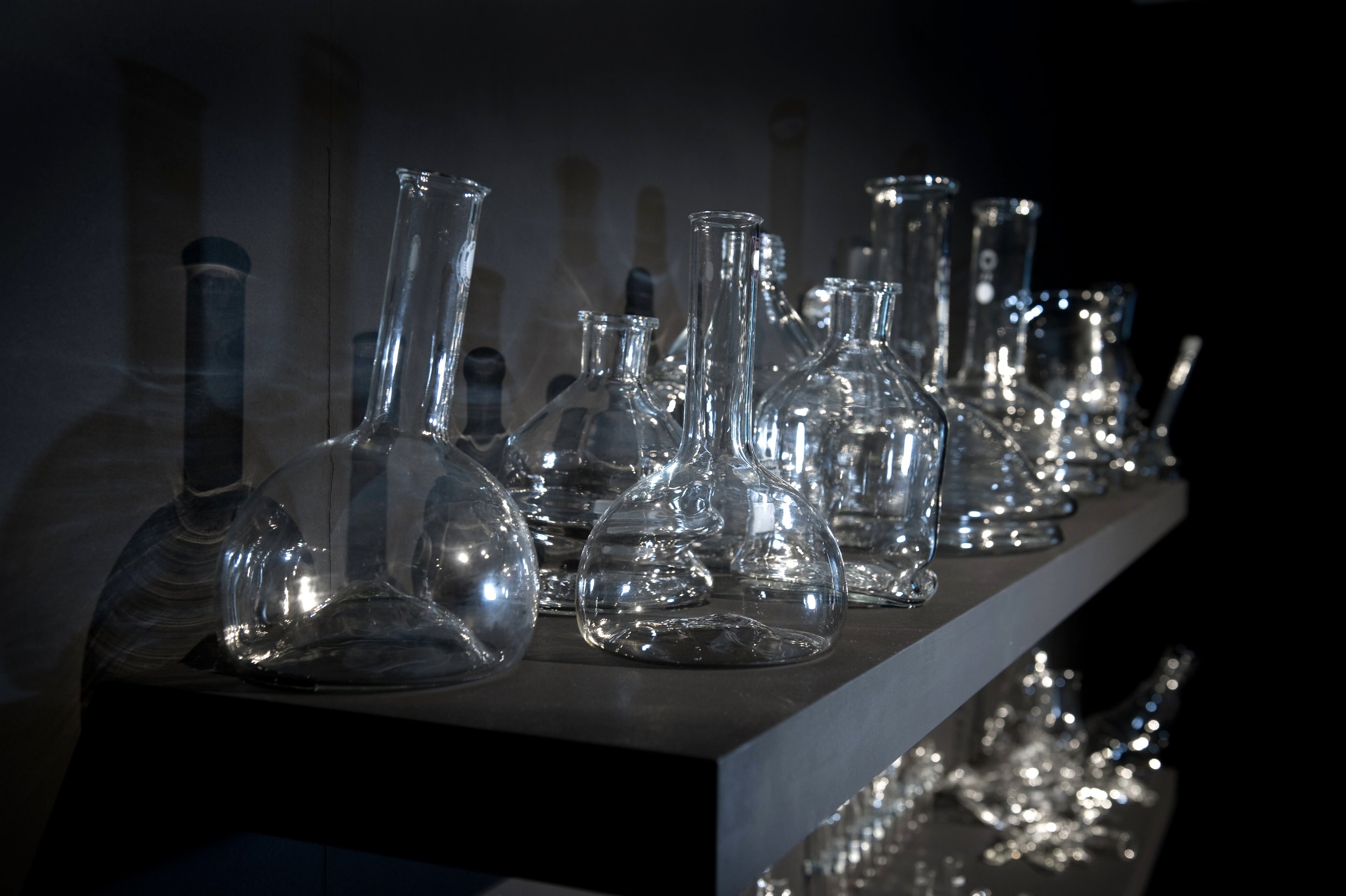Super-natural
Sneha Solanki
1-31 March 2012
Sneha Solanki, Super-natural (detail), 2012, medical glassware, video installation. Photo: Colin Davison
As part of AV Festival 12: As Slow As Possible, Vane presents two exhibitions, ‘Super-natural’ by Sneha Solanki and ‘Mesocosm (Northumberland UK)’ by Marina Zurkow.
‘Super-natural’ brings together science, art, history and technology as a starting point to this project. The work makes a connection between two points in time, the peak in witchcraft from the cusp of the enlightenment period in Western history and the emergent molecular genetic sciences of today, both periods signalling the onset of revolutionary or accelerated technological change.
‘Super-natural’ situates itself in a black space as an installation. Organised on shelving, the scientific glassware in the installation is transformed into new working vessels to visibly manifest the invisible presence of witchcraft as a stress or significant change in their baffled, mutated and melted forms. The hung glass scrying mirror peers out in the black space depicting the synthetic entities (1) ready for further and occult transformations. Constructed in a laboratory from data, formed into a ‘plasmid vector’ and transformed into the bacteria B. Subtilis 168, the synthetic entities fluoresce under ultra-violet blue light, their animated movement recorded by time-lapse microscopic photography.
fed brain and heart
kept warm and wet
digested, extracted and ligated
heat-shocked, frozen and transformed
The project draws from historical theories of witchcraft, specifically from the height of the infamous trials between the 14th and 17th centuries which describing witchcraft as “a divided self, caught between the old and the new world” (2) at the beginning of modernity, imperialism and capitalism, a divergent point where the visible socio-political effects materialised as the witchcraft trials. ‘Super-natural’ restarts this narrative in the present and also at a highly topical time by placing itself into its pre-disposed position, caught between a technological transformation in the way we view life and our future material and meta-physical state of being.
With an interest in dark materialism, ‘Super-natural’ also explores the expanded notion of media as the boundary (3) between the known and the unknown and between science and the supernatural. The immaterial, inexplicable, abstract, speculative, mythical, concrete and logical were all brought together to challenge the limits of our understanding.
‘Super-natural’ is an ongoing project with an aim to provide space, knowledge and a backdrop for discourse and dialogue.
‘Super-natural’ was made during an artist residency at the world-class research Centre for Bacterial Cell Biology, Newcastle University, between 2011 and 2012, with the Synthetic Biology Research Group, one of the few global research groups leading in this new and emerging area.
Sneha Solanki, Super-natural, 2012, video
(1) Synthetic here refers to the protocol and the emerging area in molecular sciences, ‘synthetic biology’. Synthetic biology can be defined as the creation of new life using existing or non-existing molecules that can act either naturally or un-naturally.
(2) Malcolm Gaskill, Witchcraft, A Very Short Introduction, Oxford University Press (2010)
(3) Eugene Thacker, On Horror, Supernatural and Dark Media, lecture, online at autodespair.wordpress.com (2010)
Credits and Thanks:
Thanks to Professor Anil Wipat, Dr. Jennifer Hallinan, Dr. Matthew Pocock, Sungshic Park, Goksel Misirli and a very special thank you to Dr. Wendy Smith from the Synthetic Biology Research Group in Biology Neuroscience and Computers (BNC), Newcastle University, the Centre for Bacterial Cell Biology, Newcastle University, Lindsay Duncanson and a special thanks to Sarah Blood. Thanks also to the Museum of Witchcraft, Boscastle, Cornwall for access to their private archive and library. Finally thanks to Giles and Rasa. Funded by the Arts Council England, Grants for the Arts.
AV Festival 12: As Slow As Possible takes place 1-31 March 2012 across Newcastle, Gateshead, Sunderland, and Middlesbrough. Slowness is the theme for the fourth edition of AV Festival. AV Festival 12: As Slow As Possible is a biennial Festival in slow motion, with some works running for 31 days, some for fleeting moments only, and others appearing to freeze or extend time. Spanning visual art, music, sound and film, the Festival includes over 20 exhibitions and 80 events. AV Festival 12: As Slow As Possible is funded by Arts Council England, BFI, PRS for Music Foundation, Wellcome Trust, Henry Moore Foundation, Sunderland Council and Middlesbrough Council.
Sneha Solanki, Super-natural (detail), 2012, medical glassware, video installation. Photo: Colin Davison
Take a video tour of the exhibition
Share this page




